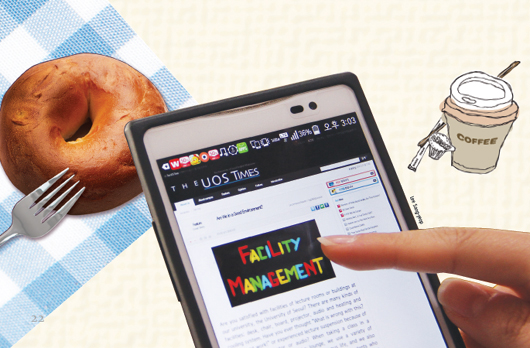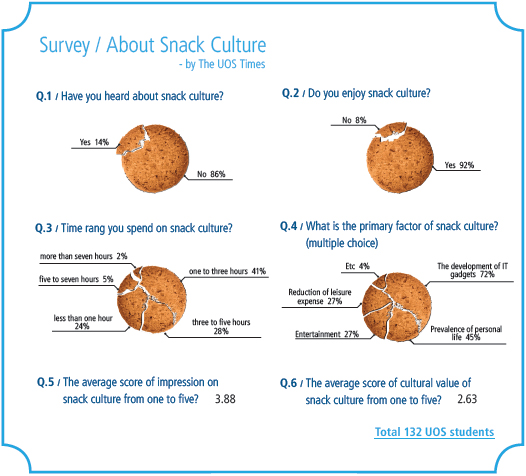
What is Snack Culture?
The expression, snack culture, was first mentioned in WIRED in 2007. WIRED is an American magazine sensitive to new cultural trends, which focuses on changes in various media outlets such as TV shows, movies, music, and business. This latest trend was named as snacks because the current culture becomes packaged, like cookies or chips, in one-bite size for a high-speed society. People can consume this culture like they consume snack. That is, snack culture is easily accessible in about 15 to 20 minutes by smartphone or tablet PC. For instance, anything accessible within a short period of time such as simple videos, novels, images, and social network services (SNS) can be seen as snack culture. In Korea, snack culture has gained popularity among the young generation.
According to the survey conducted by Ministry of Science, ICT, and Future, the total number of smartphone subscribers in Korea was over 40 million in December, 2014. Something we can effortlessly encounter via PC or mobile phone applications is webtoon, a compound word of website and cartoon. The most famous example is Misaeng. It was first published on Daum in 2012, and ever since then, it has been attracting people’s attention. It was even reproduced as a series, becoming a huge hit. Another example is broadcasting systems such as Memedia, run entirely by individuals. Just few years ago, people had to watch videos on TV or PC.
However, due to high consumption of smartphones, it has become convenient for individuals to watch videos or even share their own recordings online. As the need by the public for Memedia has increased, Internet multimedia broadcasting companies such as Pandora TV and Afreeca TV have emerged to provide the infrastructure for people. All in all, snack culture is gaining acknowledgement for its popularity and influence on our society.

Culture which Shows the Present
Snack culture does not only exist as a key form at entertainment, but it also became an enormous part of people’s daily lives and social relationships. The influence of portable devices like smartphones and tablet PC is more powerful than those of old forms of media like newspapers or TVs. Nowadays, portable devices have replaced old medias in almost every situation.
We can see why snack culture is popular in our current society by looking at the result of Survey Q4 conducted by The UOS Times. The primary factor which students thought consisted of snack culture was “The development of IT gadgets.” These days, smartphones are closely related to our daily lives. By using portable IT devices, we can express our feelings or get helpful information by sharing some posts online instead of directly meeting someone to talk or putting a lot of effort to get what you need.
The second factor is the “Prevalence of personal life.” Most of the youth lead very busy and demanding lives; it is difficult for them to make time for recreation or meet with families or friends. In this case, snack culture becomes a handy tool which goes beyond both within spatial and temporal limits. This can be also connected to the third factor, “reduction of leisure expense.” Snack culture has become the best way to enjoy an economical break from work ? all you need is a finger and a smartphone. By using smartphones, you can watch everything from web dramas to educational contents like TED talks.

As you can see from the results of survey, many students overlooked the value of snack culture as if it was unimportant. It is true that snack culture is now inseparable from our lives, but why is it worth our attention? The answer lies in the word “culture.” Throughout the centuries, many people have tried to define the meaning of culture by their own knowledge. Among various definitions of culture, there is one by Joo Chang-yoon, a Professor of Communication and Media at Seoul Women’s University. He elaborated that “Culture is like a gerund; It is both a verb and a noun. It is a verb is because it has been changing according to the social process. It is also a noun because it appears in specific forms like snack culture although it has changed from time to time. This specific form would change into verbal sense.
A series of ‘formation’ of verb and noun is what I think about.” From Prof. Joo’s definition, there are two aspects to snack culture. As IT industry has developed throughout the centuries, people enjoy “portable fun” by using their smartphones or other devices in and the midst of their busy and fast-moving lives. What reflects this tendency is snack culture, started from “instantaneity.” Now, nonetheless, it has expanded its grounds from being a light source of fun.

A word snack does not have a negative image unlike an instant food. Regardless, snack culture also cannot overlook the criticism that has surfaced. Especially, providers of snack culture are under constant pressure to post contents with more stimulating elements to draw attention. Because snack culture is prone to becoming just shallow and provocative, people tend to underestimate its value as a cultural trend.
Before judging snack culture by its cover, our first impression about snack culture is usually quite simple; It is a fun thing. It is true. When snack culture first appeared on SNS and the Internet, novels and comics online dealt with light topics. However, after snack culture turned into a main cultural trend among twenties and thirties, topics and contents of snack culture have been diversifying. The young are trying to fuse the existing culture with a new one.
There are successful attempts of such collaboration; One of the well-known examples is TED. It is a nonprofit foundation which shares valuable ideas and knowledge in the form of short lecture. TED not only goes off on a lecture tour, from schools to large conference centers, but also spreads recordings online. From these short-length videos, people can get any information they want.
TED is a form which connects lectures and the new IT outlet, YouTube, so that many people can watch funny yet intellectual videos more easily compared to the past. Another example is snack poem; this new type of poetry is extremely short and deals with various and sympathetic themes. One of the most popular poets of snack poem is Ha Sang-wook. His poem was posted on Twitter and gained popularity among users. After becoming famous, his poems became published as a book. His poems appear to have little literary value, but are still both witty and easy to sympathize. These features show a big part of snack culture.
Young people also use snack culture to reveal their opinions in funny and creative ways. This means they do not use snack culture as an instant culture but as a means of showing their political or social participation to the society.
“Nitrogen Boat,” was a satirical expression of dissatisfaction towards confectionery industries. Before the young criticized the reality of over-packaged snack, there was already criticism about Korean confectionery industries which put too much nitrogen inside snack packages. To alert this problem, some university students made a boat made of packs of snack and sailed it across Han River. Students posted a film which showed the making and sailing of the boat on SNS.
People who watched or heard the news about this challenge reposted on their SNS or KakaoTalk. Some people donated some snacks to students. After their successful sailing in Han River, the issue of over-packaged goods became official, and many media dealt with this issue. In addition, criticism of the young about “Nut Rage” also became influential in the society. After many media broadcasted the “Nut Rage” incident where Cho Hyun-ah, a vice-president of Korean Air, ordered the plane in the air to taxi back to the airport’s gate because of supposedly unsatisfactory service of a flight attendance, many satirical snack parodies followed. Comical webtoons, videos, and images criticizing Cho of her actions and idea of occupational hierarchy flooded the Internet.
These examples show how sensitive issues can also be interesting and gain social attention easily. Young people not only enjoy it as a daily leisure but access it in a high-dimensional way. To the young, snack culture is not used simply for temporary entertainment. That is, far more than they just use it, for them, it is a way to communicate with other people about many aspects of society such as politics, society, culture, and art. Snack culture is serving as an outlet for the young to express their viewpoints on the society and motivate others’ participations.

As time goes by, the main stream of culture will change, and even shorter or more temporary culture may appear in the future. Another form of network could appear and change our lifestyles. However, as we look into communicative aspects of snack culture, it is continuously being innovated by social changes and ideas of the public. It can be a key to share information and publicize opinions among people in a less sensitive way.
Park Ji-hye
pinkrabbit94@uos.ac.kr

